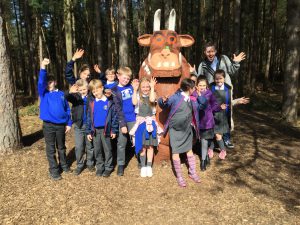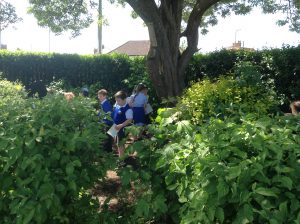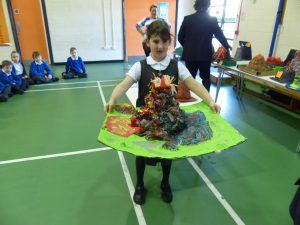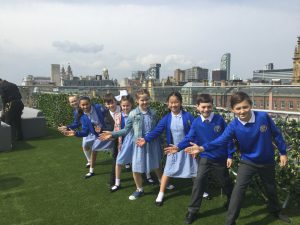Geography at Florence Melly
Geography Curriculum Rationale
At Florence Melly we are geographers! We want our children to love geography. We want them to have no limits to what their ambitions are and grow up wanting to be cartographers, town planners, conservationists or weather forecasters. We want them to embody our core values. We all believe that: “if you can DREAM it, you can do it”. The geography curriculum has been carefully crafted so that our children develop their geographical capital. We want our children to remember their geography lessons in our school, to cherish these memories and embrace the geographic opportunities they are presented with! Recently, our pupils showed their support of the national drive to improve our local coastlines and got stuck into the Great British Beach Clean. Pupils in Year 1 and Year 5 went to Crosby Beach to search for and remove litter. We are so proud of how hard the children worked, they collected a lot of rubbish. They were surprised at how much plastic they found but were also very satisfied with what they had achieved. What better way to demonstrate our core values of determination, empowerment and appreciation. Bringing geography alive is important at Florence Melly Community Primary School.
Curriculum Intent
The geography curriculum promotes curiosity and a love and thirst for learning. It is ambitious and empowers our children to become independent and resilient – like all curriculum areas.
We want to equip them with not only the minimum statutory requirements of the geography National Curriculum but to prepare them for the opportunities, responsibilities and experiences of later life. For example, our children had the opportunity to plant trees in Walton Hall Park. 30 pupils teamed up with the ‘Friends of Walton Hall Park’ and the ‘Mersey Forest Association’ to plant trees in our local park as part of a scheme to plant 1000 trees with the help of local schools. The Mersey Forest is a growing network of woodlands being created across Merseyside and North Cheshire to benefit people, wildlife and the economy. The children learned specific planting skills including: the best areas to dig, linear planting and safety when using spades. The ‘Friends of Walton Hall Park’ were on hand to support children with their planting as well as educating staff and students on how to keep the park clean and safe. The pupils thoroughly enjoyed the experience with one child commenting: “This morning was great and it was fun helping the park and protecting wildlife. I know that in a couple of years our trees will help protect squirrels, hedgehogs and birds with their habitats”.
We want our children to use the vibrancy of our great city to learn from other cultures, respect diversity, co-operate with one another and appreciate what they have. We achieve this by providing a strong SMSC curriculum, with British Values and our core values placed at the heart of everything we do. This often feeds into the geography curriculum. For example, in the spring term term the whole-school celebrated ‘Our Liverpool Home’ as a theme and as part of this themed week, children went on a special tour of our city. Children from Year 3 and Year 1 had amazing journeys on the City Explorer open top bus. They were able to take in some of our city’s wonderful historical buildings and landmarks. Starting at the Albert Dock, driving past the original eight streets of Liverpool Town 1208, the bus went past the Town Hall, Liverpool World Museum, Walker Art Gallery, St George’s Hall, China Town and both Cathedrals. The bus was full of people from other places visiting our glorious city. It was a great way to celebrate the vibrancy of our great city!
We enrich their time in our school with memorable, unforgettable experiences and provide opportunities which are normally out of reach – this piques their interests and passions. For example, our children visited a very special Liverpool landmark earlier this year. The children visited Strawberry Fields, arguably the most famous Beatles landmark. The pupils worked with Mr Doyle, our Pastoral Support Officer, looking at blue plaques around the city. They learnt about how blue plaques are used to commemorate a link between that location and a famous person or event, serving as a historical marker. They spent time listening to the famous Beatles song and learning the lyrics, researching the story behind the song and the significance of Liverpool’s legendary band. What a great afternoon they had! We firmly believe that it is not just about what happens in the classroom, it is about the added value we offer to really inspire our children.
Curriculum Implementation
In July, a complete audit of the geography curriculum was conducted. On the back of the findings from this audit, the geography curriculum has been carefully built and the learning opportunities and assessment milestones for each year group crafted to ensure progression and repetition in terms of embedding key learning, knowledge and skills. We believe that our pupils need to be actively involved in making sense of their learning and therefore an enquiry approach was implemented, encouraging higher-order thinking and allowing our children to explore in a way that is meaningful to them. Within each year group, geography strands are revisited in a progressive manner. For example, when encouraging an understanding of places and connection, Year 1 focus on observing human and physical features within a local green space. This understanding of our place in the world develops through the year groups through comparisons within the UK, Europe and the wider world and then in both Year 6 topics there is an emphasis on understanding how places across the world are interconnected and the position of Liverpool within that.
Geography subject specific characteristics, which we expect the children to demonstrate, have been developed and shared with all stakeholders. These characteristics underpin all work in geography and form a focal point for display areas and provide a common subject specific vocabulary for staff and pupils. These characteristics are:
- An excellent knowledge of where places are and what they are like.
- An excellent understanding of the ways in which places are interdependent and interconnected and how much human and physical environments are interrelated.
- An extensive base of geographical knowledge and vocabulary.
- Fluency in complex, geographical enquiry and the ability to apply questioning skills and use effective analytical and presentational techniques.
- The ability to reach clear conclusions and develop a reasoned argument to explain findings.
- Significant levels of originality, imagination or creativity as shown in interpretations and representations of the subject matter.
- Highly developed and frequently utilised fieldwork and other geographical skills and techniques.
- A passion for and commitment to the subject, and a real sense of curiosity to find out about the world and the people who live there.
- The ability to express well-balanced opinions, rooted in very good knowledge and understanding about current and contemporary issues in society and the environment.
We empower our staff to organise their own year group curriculums under the guidance of our subject leaders. Teachers are best placed to make these judgements. Staff develop year group specific long-term curriculum maps which identify when the different subjects and topics will be taught across the academic year. The vast majority of subjects are taught discretely but staff make meaningful links across subjects. They link prior knowledge to new learning to deepen children’s learning. For example, in Year 5 when the children explore ‘The Water Cycle and River Fieldwork – Why was the Mersey Tunnel built?’ they use the text ‘Garbage Guts’ by Ph D Heidi Auman in English as part of their persuasion topic. During this topic they have written to the local MP Dan Carden about single use plastic and have used recyclable materials as inspiration for their sculpture topic in art and design and have explored World Environment Day and World Ocean Day as part of their SMSC curriculum. Our children are taught the right, connected knowledge.
Our short-term plans are produced on a weekly and daily basis. We use these to set out the learning objectives for each lesson, identifying engaging activities and resources which will be used to achieve them.
We encourage staff to teach a weekly geography lesson. This was a notable change after the geography audit. This helps to ensure sufficient time is allocated to geography and that geographic subject matter can be revisited frequently. We believe that by crafting our curriculum this way, we improve the potential for our children to retain what they have been taught, to alter their long-term memory and thus improve the rates of progress they make.
Curriculum Impact
We use both formative and summative assessment information in every geography lesson. Staff use this information to inform their short-term planning and short-term interventions. This helps us provide the best possible support for all of our pupils, including the more able. The assessment milestones for each phase have been carefully mapped out and further broken down for each year group. This means that skills in geography are progressive and build year on year.
Our staff use geography formative assessment grids to systematically assess what the children know as the topic progresses and inform their future planning. These formative assessment grids then inform summative assessment judgements for each topic.
Assessment information is collected frequently and analysed as part of our monitoring cycle. This process provides an accurate and comprehensive understanding of the quality of education in geography. A comprehensive monitoring cycle is developed at the beginning of each academic year. This identifies when monitoring is undertaken. Monitoring in geography includes: book scrutinies, lesson observations and/or learning walks, pupil/parent and/or staff voice.
All of this information is gathered and reviewed. It is used to inform further curriculum developments and provision is adapted accordingly.
At Florence Melly Community Primary School, we are GEOGRAPHERS!
Key Documentation
Please use the links below which set out the vibrant Geography curriculum on offer to our pupils.
 |
Flo |  |
Flo |  |
| Geography Curriculum Map | Characteristics of a Geographer | Geography Curriculum Milestones |
Latest Geography Activities
Check out just some of the wonderful activities our children get up to in Geography. Please visit our Twitter and Flickr feeds for more fantastic activities.
 |
Flo |  |
Flo |  |
| The Great British Beach Clean | Strawberry Fields Forever | Delamere Forest and New Brighton Beach | ||
 |
 |
 |
||
| A Visit from the RSPB | Erupting Volcanoes in Year 4 | Enrichment trip to the Shankly Hotel | ||
Geography programmes of study: Key Stages 1 and 2
Purpose of study
A high-quality geography education should inspire in pupils a curiosity and fascination about the world and its people that will remain with them for the rest of their lives. Teaching should equip pupils with knowledge about diverse places, people, resources and natural and human environments, together with a deep understanding of the Earth’s key physical and human processes. As pupils progress, their growing knowledge about the world should help them to deepen their understanding of the interaction between physical and human processes, and of the formation and use of landscapes and environments. Geographical knowledge, understanding and skills provide the frameworks and approaches that explain how the Earth’s features at different scales are shaped, interconnected and change over time.
Aims
The national curriculum for geography aims to ensure that all pupils:
- develop contextual knowledge of the location of globally significant places – both terrestrial and marine – including their defining physical and human characteristics and how these provide a geographical context for understanding the actions of processes
- understand the processes that give rise to key physical and human geographical features of the world, how these are interdependent and how they bring about spatial variation and change over time
- are competent in the geographical skills needed to:
- collect, analyse and communicate with a range of data gathered through experiences of fieldwork that deepen their understanding of geographical processes
- interpret a range of sources of geographical information, including maps, diagrams, globes, aerial photographs and Geographical Information Systems (GIS)
- communicate geographical information in a variety of ways, including through maps, numerical and quantitative skills and writing at length.
Attainment targets
By the end of each key stage, pupils are expected to know, apply and understand the matters, skills and processes specified in the relevant programme of study.
We are not required by law to teach the example content in [square brackets].
Subject content – Key stage 1
Pupils should develop knowledge about the world, the United Kingdom and their locality. They should understand basic subject-specific vocabulary relating to human and physical geography and begin to use geographical skills, including first-hand observation, to enhance their locational awareness.
Pupils should be taught to:
Locational knowledge
- name and locate the world’s seven continents and five oceans
- name, locate and identify characteristics of the four countries and capital cities of the United Kingdom and its surrounding seas
Place knowledge
- understand geographical similarities and differences through studying the human and physical geography of a small area of the United Kingdom, and of a small area in a contrasting non-European country
Human and physical geography
- identify seasonal and daily weather patterns in the United Kingdom and the location of hot and cold areas of the world in relation to the Equator and the North and South Poles
- use basic geographical vocabulary to refer to:
- key physical features, including: beach, cliff, coast, forest, hill, mountain, sea,ocean, river, soil, valley, vegetation, season and weather
- key human features, including: city, town, village, factory, farm, house, office, port, harbour and shop
Geographical skills and fieldwork
- use world maps, atlases and globes to identify the United Kingdom and its countries, as well as the countries, continents and oceans studied at this key stage
- use simple compass directions (North, South, East and West) and locational and directional language [for example, near and far; left and right], to describe the location of features and routes on a map
- use aerial photographs and plan perspectives to recognise landmarks and basic human and physical features; devise a simple map; and use and construct basic symbols in a key
- use simple fieldwork and observational skills to study the geography of their school and its grounds and the key human and physical features of its surrounding environment.
Subject Content – Key Stage 2
Pupils should extend their knowledge and understanding beyond the local area to include the United Kingdom and Europe, North and South America. This will include the location and characteristics of a range of the world’s most significant human and physical features. They should develop their use of geographical knowledge, understanding and skills to enhance their locational and place knowledge.
Pupils should be taught to:
Locational knowledge
- locate the world’s countries, using maps to focus on Europe (including the location of Russia) and North and South America, concentrating on their environmental regions, key physical and human characteristics, countries, and major cities
- name and locate counties and cities of the United Kingdom, geographical regions and their identifying human and physical characteristics, key topographical features (including hills, mountains, coasts and rivers), and land-use patterns; and understand how some of these aspects have changed over time
- identify the position and significance of latitude, longitude, Equator, Northern Hemisphere, Southern Hemisphere, the Tropics of Cancer and Capricorn, Arctic and Antarctic Circle, the Prime/Greenwich Meridian and time zones (including day and night)
Place knowledge
- understand geographical similarities and differences through the study of human and physical geography of a region of the United Kingdom, a region in a European country, and a region within North or South America
Human and physical geography
- describe and understand key aspects of:
- physical geography, including: climate zones, biomes and vegetation belts, rivers, mountains, volcanoes and earthquakes, and the water cycle
- human geography, including: types of settlement and land use, economic activity including trade links, and the distribution of natural resources including energy, food, minerals and water
Geographical skills and fieldwork
- use maps, atlases, globes and digital/computer mapping to locate countries and describe features studied
- use the eight points of a compass, four and six-figure grid references, symbols and key (including the use of Ordnance Survey maps) to build their knowledge of the United Kingdom and the wider world
- use fieldwork to observe, measure, record and present the human and physical features in the local area using a range of methods, including sketch maps, plans and graphs, and digital technologies.
